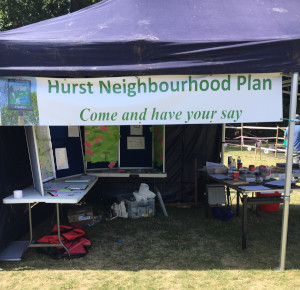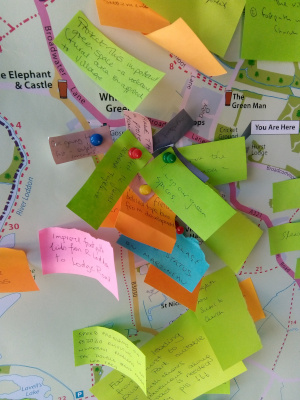Hurst Show 23rd & 24th June 2018
Summary of the Hurst Show Consultation
The Neighbourhood Plan team ran a consultation activity at the annual Hurst Show and Country Fayre on 23rd and 24th June 2018 in order to:
- Raise awareness of our Neighbourhood Plan and the process
- Provide information on how people can get involved in the Neighbourhood Plan
- Gather initial responses on what people like/dislike about the area
- Open up a conversation about the vision for Hurst (i.e. for the next 20 years)

How did this work?
To start a discussion about what local people like about the area, what they would like to change and how it could be made better we created the following:
- A “wish wall”. Where people stuck up post it notes to capture their wishes for the area, asking them specifically to thinking about the future of Hurst;
- A “bug wall”. Where people can stick up post it notes to capture what they don’t like about the area i.e. what bugs them!
- A large map of the Parish of St Nicholas Hurst which was used to open up a conversation about the neighbourhood plan, and people used this to stick location specific issues.
Who took part?
We spoke to 136 people over the two days, 71 on the Saturday and 65 on the Sunday. In terms of the demographics, the respondents ranged from residents to visitors, from older people to families (fitting with the wider sample of those who attended the Hurst Show and Country Fayre).
What did people say?
We collected a total of 215 comments about Hurst (109 wishes, 65 bugs and 41 specific comments on the map). 85% of the comments were from residents of the Parish of St Nicholas Hurst and 15% from visitors.
All the responses and comments were written up in an excel file. The collated comments were analysed: a process of interpreting the comments, identifying similar phrases whilst searching commonalities and differences. A thematic framework was developed for the analysis which included codes and themes on a range of topics about the local area.

The key findings that emerged from the analysis are summarised below:
- The overall findings of the consultation exercise indicate that a range of features of Hurst were rated positively; key features that were mentioned included the rural landscape, the character of the area, the sense of community and the local amenities (i.e. schools, shops, parks). The blend of the natural environment, social and community infrastructure and a strong, cohesive community were perceived as positive features of the area. Undeniable there was immense pride in the area.
- The findings indicate that the majority of “bugs” about Hurst related to transport issues (69% of comments fell under this theme). Specifically, respondents referenced speeding, safety of pedestrians and cyclists and the provision of footpaths. The second largest “bug” related to local environmental issues, specifically, but not exclusively, dog fouling, litter, fly tipping and maintenance of verges.
- In terms of thinking about the future of village this raised a variety of ideas. Again, the majority of comments relating to transport, with a focus on traffic calming and the provision of footpaths (29% of wishes); 24% of the comments were about social and community infrastructure (with suggestions including the schools, the post office, events like the shows, the provision of facilities for older and young people); 14% of comments were about housing and future development; and 13% related to the natural environment (which focused on the protection and preservation of the natural environment). However, it was the mapping exercise which brought this issue to the fore. Nearly half of the comments from the mapping exercise related to natural environment, in terms of the recognising the green and open spaces in the area and the potential preservation and protection of such spaces (44%).
In summary, there is incredible enthusiasm about the local area with respondents noting many positive features of Hurst. However, there was concern over the future of the area, in relation to growth and development, a concern routed in the need to ensure that the positive, unique features that make Hurst a special place remain.

